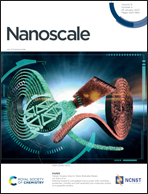Threshold switching in nickel-doped zinc oxide based memristor for artificial sensory applications†
Abstract
Electronic devices featuring biomimetic behaviour as electronic synapses and neurons have motivated the emergence of a new era in information and humanoid robotics technologies. In the human body, a nociceptor is a unique sensory neuron receptor that is capable of detecting harmful signals, leading to the central nervous system initiating a motor response. Herein, a nickel-doped zinc oxide (NZO)/Au based memristor is fabricated for the first time and characterized for artificial nociceptor application. For this, the introduction of a nickel-doped zinc oxide (NZO) layer between P++-Si and Au electrodes is used to eliminate the surface effects of the NZO layer, resulting in improved volatile threshold switching performance. Depending on the intensity, duration, and repetition rate of the external stimuli, this newly created memristor exhibits various critical nociceptive functions, including threshold, relaxation, allodynia, and hyperalgesia. The electron trapping/detrapping to/from the traps in the NZO layer is responsible for these nociceptive properties. This kind of NZO-based device produces a multifunctional nociceptor performance that is essential for applications in artificial intelligence systems, such as neural integrated devices with nanometer-sized features.



 Please wait while we load your content...
Please wait while we load your content...